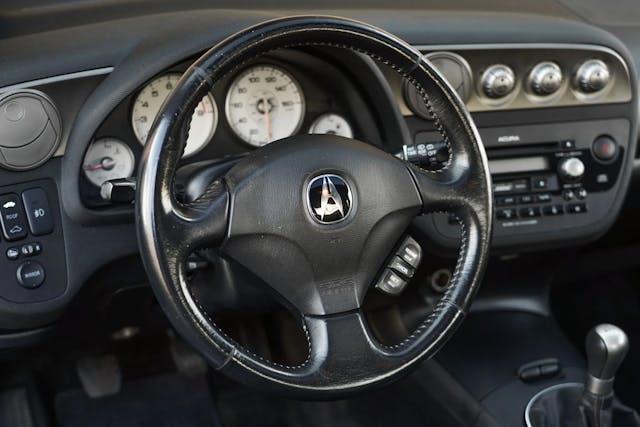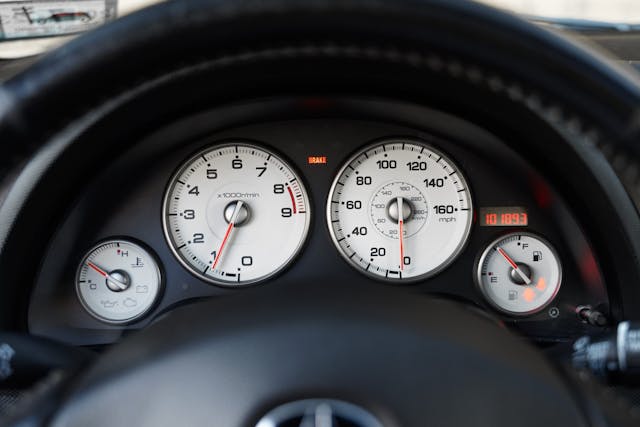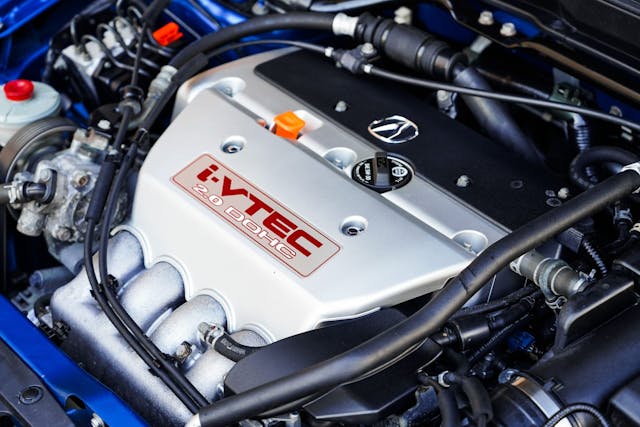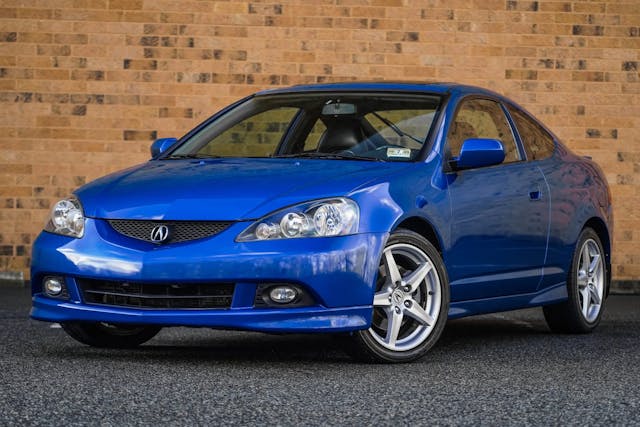Media | Articles
Original RSX: Is the Integra by Another Name Still Collectible?
The reveal of Acura’s new RSX EV prompted Hagerty Media staff to remember the original RSX that was produced from 2001 to 2006. An Integra in all but name, that RSX lived in the long shadow of the preceding generation’s Integra Type-R but nonetheless proved to have a strong following of its own. This story, which originally appeared on Hagerty Insider in February 2023, highlights how the RSX coupe has become a collectible in its own right. We’ve updated the data to reflect the current market.—Ed.
Our conversations about modern Japanese collector cars tend to circle around a handful of fan favorites. Honda Civics and Mazda Miatas at the low end; Nissan Skylines and Lexus LFAs at the top; Nissan Zs, Toyota Supras, and Mazda RX-7s somewhere in the middle. Yet the great thing about modern Japanese enthusiast cars—and maybe something that distinguishes them to a certain degree from other regions and eras—is that there were just so many of them. Mitsubishi Starions, Eclipses, 3000GTs. Nissan 240SXs, Sentra SE-Rs. Honda Preludes, S2000s, CRXs. Toyota Celicas, Corolla GT-Ss, MR2s. It goes on and on.
If you grew up in the 1990s like I did, these cars seemed to fill every parking lot. Some were obviously better than others—and only a few were genuinely fast—but the general competency level was so high among Japanese automakers during this time that just about all of them were entertaining.
The result, as the survivors from this era age into collectibility, is that I occasionally find myself stunned to see a high price attached to a car I’ve scarcely thought about in more than a decade—and then kick myself for not grabbing one when I could have. Such is precisely the case with this Sale of the Week, a 2006 Acura RSX Type-S that sold on Bring a Trailer for $22,838, including fees. That price might not seem terribly high in a vacuum (or relative to the $10.6M Bugatti we picked the week before), but it’s a lot of coin for a nearly 20-year-old car with more than 100,000 miles on its odometer, especially one that has lived its entire life in the salty climes of New Jersey. It’s also quite a bit higher than the average value people state when they call Hagerty for insurance on an RSX, currently around $13K, a figure that’s up 16.3 percent over the last three years.

And yet the price kind of makes sense. The RSX, which debuted in 2002 as the successor to the 1997–2001 Integra, has pretty much all the qualities that Japanese car lovers crave: A free-revving four-cylinder (210 hp at 7800 rpm), a snick-snick six-speed manual, and wonderful steering and handling. It also happens to be one of the more handsome cars of its ilk—upscale and understated but sporty and purposeful. (Its white-face gauges might even give the contemporary Lexus IS a run for its money as the best-looking from the era.) And whereas small Hondas from the 1980s and even the ’90s can feel just a tad uncomfortable in traffic among today’s 400-hp luxo-barges, the RSX, which hits 60 mph in less than seven seconds and has a sixth gear for highway cruising, has no such issues.
Marketplace
Buy and sell classics with confidence

What it lacks—and what might explain why this price is as yet a bit of an exception rather than commonplace—is a name. Really, two names. The first is “Integra.” Although this same car wore that badge in Japan, Acura executives at the time were eager to move upscale and ditched the badge for more fashionable alphanumerics. The second was “Type-R.” Although the 1997–2001 Integra Type-R is remembered as one of the “it” cars of the era and today can command more than $80K in top condition—to say nothing of the eye-watering $151K record for a Type-R set in 2023—it was a slow seller at the time. The RSX Type-S effectively replaced the Integra GS-R, which had been more popular with American buyers than the Type-R thanks to its lower price point and similar on-paper performance. (Again, Japan had it better: The JDM Integra Type-R of this era made 220 hp from a screaming normally-aspirated four cylinder.)
It’s thus little surprise that 1994–2001 Integras, while older and less powerful, tend to fetch more money. The average value cited by people who call us for insurance on them is about $36,200–significantly higher than for the RSX, though skyrocketing Type R values do have a strong influence on that number.
Yet these underrated coupes may get the last laugh. Nearly 80 percent of the people calling us about RSXs are millennials or younger, well ahead of their 30 percent share of the overall collector market. Quote volume is impressive, too, more than doubling from 2022-24. As the fortunes of these up-and-coming collectors improve, so might the values of the cars they crave.

Such would be fitting for a car that, in many respects, represents the tail end of the golden age for affordable Japanese enthusiast cars. The RSX hit the market just as the SUV craze was hitting the U.S. market in earnest—light trucks outsold passenger cars for the first time in 2002 (today trucks outsell cars three-to-one). By the time it departed in 2006 (also the final year for the venerable Toyota Celica), the die was cast. By now, small and sporty coupes, which were mainstream cars through the 1980s and ’90s, are critically endangered. Ditto for high-revving, normally-aspirated four-cylinders. All to say the RSX, which was never all that common to begin with—in its best year Acura sold just 30,117 of them—is only going to become more special as time goes on, and as contrasts are drawn with the new RSX EV.
***
Check out the Hagerty Media homepage so you don’t miss a single story, or better yet, bookmark it. To get our best stories delivered right to your inbox, subscribe to our newsletters.
Via Hagerty Insider




I’ve always wondered if you guys would ever talk about this car, especially making a video about it. It has its place in automotive history on the Acura lineup. I bought this car on late December 2021 with 100,998 miles on the odometer, a blue 2002 Type-S on mint condition 100% stock. Not only is the insurance super cheap but is a car that literally no one has one anymore. It may not be too fast, but is unique and rare to see around. I get compliments here and there, and it’s a great platform for motorsport and aftermarket support. Even Mugen & Spoon Sports has used this car. Doug Demuro almost had the chance to review my car but he was already back to California before I knew he was in Michigan for some days.
Hopefully this car would make it at Hargety’s YouTuBe channel.
An 03 Type -S in arctic blue was the first new car I ever bought as an Adult. Loved that thing and only got rid of it in 2014 when kids just made a small car impractical.
Never realized at the time I owned the last of an era but it makes sense in retrospect. Makes me feel a bit old these are becoming “classics” now
Nearly picked one of these up in 2009 as a fun year-round car (grabbed a Mitsubishi Evolution IX instead, still have that). The RSX-S has aged pretty well. I see them in two conditions in 2023 – completely clapped out, rusty and faded, or pristine and garage kept. Such is the fate of all enthusiasts’ cars that ride the line between classic and used car.
You chose correctly with the Evo IX.
I would also have picked an EVO over an RSX but they are two very different cars. The RSX was a great car back in the day and still a good choice if you can find one not destroyed by it’s former owners.
Had a satin silver brand new in 2003. It was the first I ever bought out of college and it got me into cars based off it it’s online community which was new and novel in 2003. The idea of modifications and going fast created an itch.
It was a good car that I lightly ruined with mods and I didn’t realize it till I put it back to stock to trade it in for a civic si.
The RSX was never on par with the Integra, Prelude, or Civic SiR (Canadian car Si in US.) The suspension let it down with front strut suspension instead of wishbones. Decent car, but somewhat cramped and unrefined.
As someone who owned a 3rd-gen Integra when these cars came out, I found them massively disappointing. Honda had committed an unforgivable offense in my eyes by getting rid of their double wishbone suspension in favor of MacStruts. The SLA suspension was really the main thing differentiating Honda’s sporty compacts of the ‘90s from most of their competitors.
I test drove one in the summer of 2001, and also found that I didn’t much care for the new cable shifter, and the K20A felt sluggish to rev compared to a B18C.
After waiting eight years for Honda to release a new Integra, this was not at all the car I wanted. I was glad Acura named it something else in the American market. But I can see why people who did like them would still want one today.
Had an ‘05 on my shopping list in ‘07 (along with a WRX and MINI Cooper S) and it seemed like exactly what it was: a grown-up Integra. 210hp from a normally-aspirated 2.0 liter motor still isn’t anything to sneeze at almost 20 years later. I didn’t really mind the shifter that much having come from a CRX and a host of mid-engine cars, all with various wet-noodle connections to their transmissions.
Of the three, the MINI was the most fun, handled the best, and had the best build quality. I would have bought it, but at the last minute my company called and said they’d found a company car for me.
Turns out free trumps fun, handling, and build quality….who knew?!
Agreed with most of the article except the rankings. IMO, the Toyota Supra and Nissan Skyline are at the top of Japanese sportscars, and Lexus LF-A is at the top of Japanese supercars rankings.